2 AOPS Operating Areas
The AOPS will normally operate in the areas of the Atlantic, Pacific and Arctic Oceans and
contiguous Canadian waters that constitute the Canadian Territorial Sea, Contiguous Zone, Exclusive
Economic Zone and Continental Shelf as defined in the Oceans Act.
Notwithstanding the normal operating areas, the AOPS shall be capable of worldwide operations in
littoral and open ocean conditions.
3 CONCEPT OF AOPS HELICOPTER OPERATIONS
3.1 General
Within the limits and restrictions described below, the AOPS shall be capable of:
a. controlling an approaching helicopter,
b. recovering a helicopter to the flight deck,
c. launching a helicopter from the flight deck,
d. controlling a departing helicopter,
e. securing a helicopter on the flight deck, and
f. fuelling a helicopter on the flight deck.
¹ The Canadian Coast Guard is in the early stages of a project to replace its fleet of helicopters.
The intent is to acquire 6 medium twin engined helicopters and 16 light twin engined helicopters.
The likely candidates to fill the requirement for medium helicopters are the Bell 412, the
Eurocopter EC 155 and the AgustaWestland AW139. The likely candidates to fill the requirement for
light helicopters are the Bell 429, the Eurocopter EC 135, the Eurocopter EC 145 and the
AgustaWestland AW109. For the purposes of this specification and because it has the largest (an
thus most demanding) folded dimensions, the future Canadian Coast Guard medium helicopter is
assumed to be the Bell 412 with optional blade folding kit. Note that Canadian Coast Guard
helicopters are operated by Transport Canada on behalf of the Coast Guard.
6 of 47
Arctic Offshore Patrol Ship Helicopter/Ship Interface Requirements Rev 3
The AOPS shall be capable of HIFR in accordance with CFTO C-12-124-A00/MB-002 Shipborne Helicopter
Operating Procedures (SHOPS) (dated 14 May 2008), Section 3 – Helicopter Fuelling Procedures.
The AOPS shall be capable of VERTREP in accordance with SHOPS, Section 4 – Vertical Replenishment,
Hoist Transfers and Administrative Flights.
3.2 Canadian Coast Guard Helicopter
The AOPS will operate a Canadian Coast Guard helicopter during deployments to the Canadian Arctic.
The AOPS may operate a Canadian Coast Guard helicopter on occasion during deployments in other
Canadian waters, including: the Atlantic Ocean, the Pacific Ocean, the Gulf of St. Lawrence and
the Great Lakes.
The AOPS will employ the Canadian Coast Guard helicopter for:
a. ice reconnaissance,
b. personnel and light cargo transfer between ship and shore,
c. medical evacuation, and
d. Search and Rescue.
The AOPS shall operate Canadian Coast Guard helicopters²:
a. day and night,
b. under Visual Flight Rules (VFR) and Instrument Flight Rules (IFR)³,
c. in seas up to and including the top of Sea State 3⁴,
d. at any ship’s speed,
e. at any relative heading, and
f. at any relative wind over the arc from 30 degrees port to 30 starboard at any speed up to 35⁵
knots.
The AOPS shall be capable of:
a. moving a Canadian Coast Guard helicopter from the stowed position in the hangar to the ready
position on the flight deck,
b. moving a Canadian Coast Guard helicopter from the landing position on the flight deck to the
stowed position in the hangar,
c. sheltering a Canadian Coast Guard helicopter in the hangar,
² These requirements are notional. Based on discussions with the pilot on CCGS Louis S. St.
Laurent, neither Transport Canada nor the Canadian Coast Guard has ship motion limits or any other
formal helicopter clearance criteria; the pilot will fly from and to the ship if he/she believes it
can be done safely. ³ The future fleet of Canadian Coast Guard helicopters will operate under both
VFR and IFR.
⁴ From STANAG 4194 Standardized Wave and Wind Environments and Shipboard Reporting of Sea
Conditions, Table D-1 NATO Sea State Numeral Table for the Open Ocean North Atlantic, Sea State 3
has significant wave heights ranging from 0.5 metres to 1.5 metres and a modal period ranging from
5 seconds to 14.8 seconds.
⁵ The limit of 35 knots is an estimate that must be confirmed. CFTO C-12-146-000/MB-002 CH 146
(Griffon) Flight Manual, Book 1 of 3, Section 1, 1.9 Airspeed states that the “maximum allowable
tailwind or crosswind speeds for hover operations … is 35 knots”.
7 of 47
Arctic Offshore Patrol Ship Helicopter/Ship Interface Requirements Rev 3
d. securing a Canadian Coast Guard helicopter in the hangar,
e. securing a Canadian Coast Guard helicopter on the flight deck, and
f. providing logistical support to a Canadian Coast Guard helicopter.
The AOPS shall provide sufficient protection for one Canadian Coast Guard helicopter for it to
survive the same high sea states experienced by the AOPS.
The AOPS shall provide the facilities and services required to maintain one Canadian Coast Guard
helicopter for deployments of up to 120 days duration, during which the helicopter is assumed to
fly for a total of approximately 150 hours⁶.
The AOPS shall carry sufficient aviation fuel to support the assumed operational tempo of one
Canadian Coast Guard helicopter.
The AOPS shall be capable of supporting personnel and light cargo transfer by a Canadian Coast
Guard helicopter.






